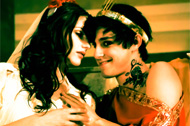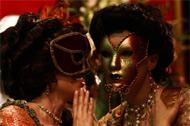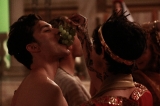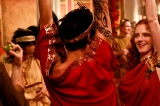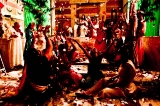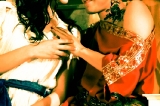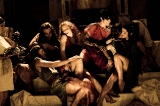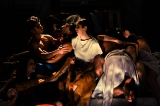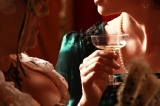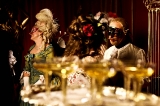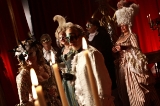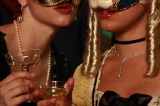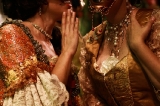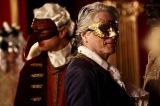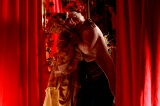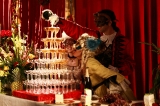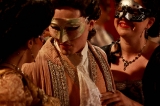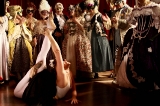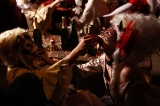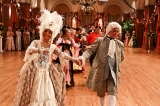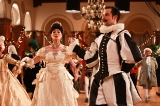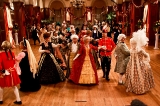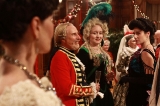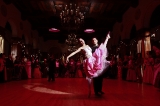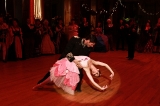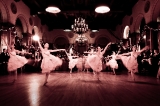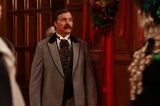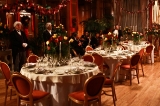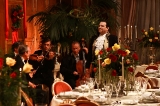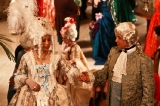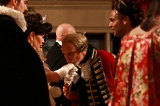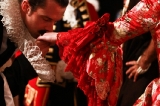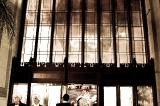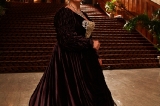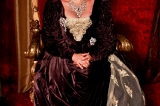[tab:Party Like]
Ancient Feasts
For thousands of years mankind has shared a universal desire that transcends time, race and culture. We all love to party. This groundbreaking three-part mini-series is a sumptuous and decadent journey to savor the greatest parties the world has ever known, past and present. Discover how emperors, queens and the super-rich liked to celebrate and the party planners who risked everything if it went wrong.
Episodes
[tab:Photos]
Emperor
Queen Of France
Rich And Famous
[tab:Facts]
Series Accomplishments
Locations: Paris, Versailles, Rome, London, Brighton, New York, New Orleans, Las Vegas, Los Angeles
Actors: Over 200 actors in period accurate costumes, many of the costumes were hand-made.
Hair/Makeup: Over 120 period accurate wigs with authentic make-up.
Specialist Masks: Over sixty high-quality masks produced.
Crew: Over 130 professionals employed in every field of filmmaking, from crane-operator to camera to catering.
Sets: 25 period accurate sets designed, built, lit and photographed.
Dancing: 6 original choreographed dances, performed by 35 professional and semi-professional dancers.
Opera: A specially commissioned opera written and performed with professional opera singers.
Specialist Entertainers: Snake charmer, Contortionist, Magician
Props: 150 specialist hand-made props
Music: 30 original compositions. 120 pieces of music used across the series
Musicians: 20 period accurate musical instruments employed
Animals: Cobra, horses, roosters, nightingales, camels, ostrich, elephants, tigers.
Modern Parties: New York, Las Vegas, Los Angeles, New Orleans.
Experts: 26 professional experts interviewed around the world.
Release Forms: Around 1000 signed release forms.
Vis FX Shots: Over 250 complex visual effects shots. Almost half of them are 3D wire-frame shots.
Edits: More than 6000 edits across three films.
[tab:Blogs]
Party Like A Queen
Blog by Aidan Pickering – Series Producer
The sudden appearance of a horse has set in motion of all sorts of chain reactions throughout history. The arrival of Pegasus, the winged horse of Greek mythology, spelled the end for the monster Chimera. In 11th Century Vietnam, a vision of a white horse convinced King Ly where to build his citadel. So it may be that I was unwittingly following a well worn path in history when I saw two white horses with riders trotting through the courtyard of Versailles and off down the tree-lined vista that stretches for miles. It really felt as though I had just seen a ghost: the ghost of Marie-Antoinette. Let me back up.
I was at Versailles taking photographs of the magnificent palace gardens for use in Party Like A Queen, the episode that tells the story of the young queen of France, Marie Antoinette and her hard partying ways. I had watched as the morning sun lit up the gold painted palace gates and made the place look like it was on fire. I had wandered among the symmetrical rows of cone-shaped hedges, picturing what it must have been like when the 14-year old Austrian Princess arrived here for the first time to be the young bride of the future King Louis XVIth. I saw her harp still there in her music room, her rococo bedroom and boudoir at Le Petit Trianon, the small chateau in the palace grounds that Louis gave to her. All these objects were memorabilia. Until I saw those horses. Only then did I imagine this child of privilege turned woman of power actually riding through the palace grounds. Now I could see her plotting to establish herself at court, striving to be taken seriously, seizing on, of all things, fashion as a way to make herself larger than life, quite literally. I imagined as her horse’s hooves crunched across the gravel, an army of dressmakers turning miles of silk into ball gowns the likes of which had never been seen. Seriously wide dresses; impossibly tall hair. She wanted to be an imposing figure to calm the wagging tongues. That’s what she became: with her pouf hair and breath taking dresses stretched over a broad metal frame, some nights she would have measured about eight and half feet tall by about five and a half feet wide. It must have been like Shaquille O’Neal entering the ballroom.
The next part of the story everyone knows. She spent, and spent and spent. The French people blamed her for all of the nation’s ills. They revolted. She and Louis lost their heads at the guillotine. Suddenly I felt sorry for Marie-Antoinette. She was a child when she first came here. I am sure she could have made better choices. But can you really blame the Queen of Fashion for single handedly plunging the nation into debt? Hardly. Still, she joined a long procession of kings, queens, dictators and despots who lost touch with their people and met the executioner’s blade. I prefer to imagine her riding on the back of one of those white horses I saw, planning her next fashion statement, eager to define herself by setting the next daring trend. I wonder if the biggest mistake she made was being born a couple of hundred years too early.
Party Like An Emperor
Blog by Aaron Even – Episode Writer
“I’ve been up for three days straight.” That’s what the bleary-eyed set designer told me as I stepped inside the newly constructed royal palace of 3rd century Roman emperor Elagabalus. It wasn’t quite finished yet: a few touches needed here and there, some last minute painting, some drapes, a few faux torch flames to add a bit of class—oh yeah, and a swimming pool. Jeez.
Glad to be a mere script writer. Just words on a page. You don’t have to actually build the things you imagine. But it’s incredible to consider the consequences that unfold from typing lines into a word processing program. Turns out that a script is much more than just a story you tell: for others it’s a battle plan that must be broken down immediately into a series of concrete actions. So much wood to order, statues and plants to find, how do you make one doorway pass for two? This platform must be strong enough to hold a crowd, the floor must look like marble which, of course, we can’t remotely afford, and so on and so on.
There comes a moment when you feel actual guilt. Did I have to write a chariot into that scene? Why didn’t I stop to consider that chariots aren’t the easiest things to find or to build? And when the emperor sends a rain of flower petals onto his guests—although it’s accurate history and a perfect illustration of his excessive character—did I pause to consider the poor souls who would have to (and they actually did this) pluck hundreds of individual petals from real roses? Alas, I did not. Probably shouldn’t, since an excess of empathy would no doubt move me to write some of the most boring scenes imaginable.
“Emperor enters a very plain and easily lit room. Wait: natural light is fine. He wears, uh, regular clothes will do. My dear, he says. Suddenly a live Siberian tiger crosses the frame and he turns…” See? I couldn’t help myself.
In just a few hours, though, the incredible artists and carpenters and electricians and swimming pool builders managed to finish off a scene of great gluttony and decadence—a palace room filled with rich tapestries, glittering water, dancing flames, Romanesque statues, tables and couches on which heaping platters of meats and fruits overflowed, an emperor’s throne, and a play of light and shadows that perfectly suggested a luxurious palace at night.
And they only went three days without sleep to do it.
Party Like An Emperor
Blog by Calder Greenwood – Episode Co-Director & Series VFX Supervisor
The creation of ancient Rome in modern-day Los Angeles was a daunting task – where could we find a location suitable to recreate an epic party circa 200 AD? Not to mention the various other scenes called for – the Roman forum, streets and alleys, temples, palaces, hallways and forts. In the end we decided to build Rome ourselves in a studio. But with limited space and a tight budget, we had to get creative. From the earliest stages of pre-production, we began to design the space to be multi-purpose, multi-functional. Working closely with the art department, we designed rotating walls that on one side could be a temple, on the other a military fort. The same columns appeared on the palace steps as lined the temple hallway. Dirt mats were dragged in to cover the tile floor to make interiors exteriors. And cleverly placed green screens allowed us to extend the sets on to infinity.
We also had local re-enactors, who could provide their own costumes, props, arms and armor appear as extras in the film. Many were well versed in customs and practices of ancient Rome, and were able to lend authenticity to the scenes we shot – what foods would have been served, how they would be eaten, how swords were drawn from scabbards.
One of the most impressive builds for the set – a fully functional heated pool – was also one of the most complicated. With enough water to literally wash away our set, it had to be built to hold over 1,000 gallons of pressure. It also had to be drained immediately once the scene was shot, so it could be broken down to make room for more sets ready to be swapped in to the limited stage space.
Over 12 sets were erected and shot during the three day production. Somehow we pulled it all off on time and on budget. Although we’re currently still in post-production, I have the utmost confidence that this will be an episode that will have to be seen to be believed.
Party Like An Heiress
Blog by Philip J Day – Executive Producer & Director
The Waldorf Astoria in New York is one of the most famous hotels in the world – and has always been on my bucket list to go and stay there. But such is my budget that it didn’t really seem on the cards. That was until I took on the new series Party Like about the greatest parties in history. The Waldorf had played host to one of the world’s most expensive parties back in 1897 and so became the focus of one of our episodes.
We contacted the hotel and they agreed to let us film there over two days in February 2011. We were focused on the annual Viennese Opera Ball that takes place in the Waldorf’s Grand Ballroom . As our filming budget was extremely tight and New York is an expensive city I thought it was worth asking to see if they would comp me a room. Most hotels usually say no to these requests but as this was such a positive story I thought it was worth asking. The request went through the various levels of command – and a week later I was delighted to be told that the hotel was prepared to provide a room. I went on-line and checked out pictures of the ballroom, the great lobby, the dining rooms, and, of course, the bedrooms – all of them beautifully appointed. I was excited to see it all.
A few weeks later I arrived in New York on a freezing February afternoon . I would be using a local film crew so I was staying at the hotel by myself. When I arrived at the Waldorf Astoria on Park Avenue I looked up at the grand building and felt a tingle of excitement. This hotel had so much history running through its corridors that I couldn’t wait to see it. At check-in I was surprised when I was offered not just a bellman to collect my bags but an escort to take me to my room. As I walked behind the young lady I wondered which of the rooms would be mine. To be honest I expected to be in a small single room next to a noisy elevator. But we kept on walking, past every room along the 33rd floor corridor. I thought she’d made a mistake, as the only thing left was a huge double door at the very end of the corridor. But then she applied a room key and invited me to enter.
This was no hotel room, more like a mansion. The suite was so big that I could have housed an entire hockey team and still had room for the coaches . The reception area alone was as big as most hotel rooms. Then that opened onto the main lounge – a magnificent space with paintings and décor that normally is the reserve of museums and stately homes. At one end a twelve-seat mahogany dining table overlooked the Chrysler building a few blocks away.
It took me almost a minute to walk from the lounge to my vast bedroom. The bed was the size of a small island – I’d never seen anything like it. Truly incredible – and while I felt totally undeserved of such magnificence I wasn’t about to complain. It was just a shame that I couldn’t fill it with my friends and have the biggest party since 1897 – there was certainly the room to do it in. But it was certainly a wonderful way to cross off such a major thing on my bucket list.
[tab:Press]

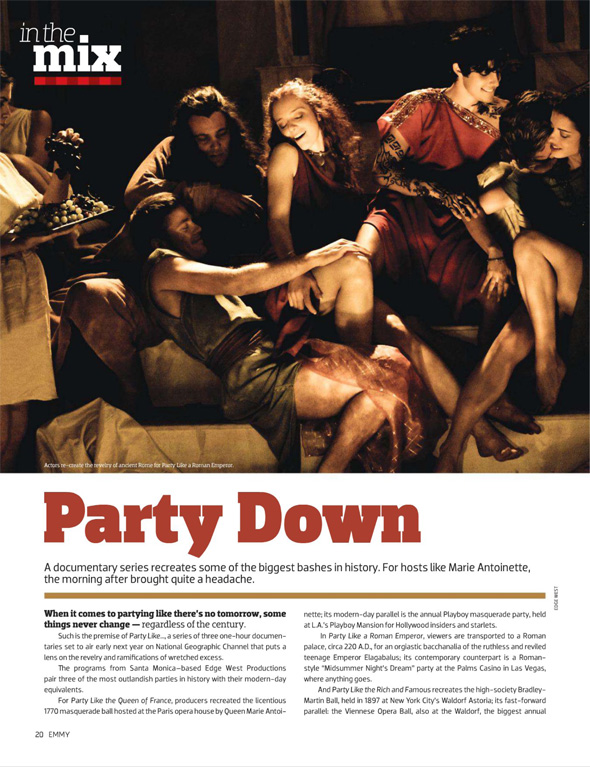

[tab:Trivia]
Party Like An Emperor
Food
1. Greek hosts always mixed wine with water to ensure that their guests did not become drunk too quickly!
2. Much of what one might think of as “Roman cuisine” was actually a style of cooking imported from Greek culture. Prior to their exposure to the Greeks, the Romans were actually called “porridge-eating barbarians.”
3. The main adaptation from Greek food was the Roman emphasis on spicing. Whereas most Greek dishes contained perhaps three or four spices, the Roman dishes were reminiscent of Indian food – packed with up to ten spices to create a powerful and unique flavor.
4. Rome had its own equivalent of modern day fast-foot restaurants that were called popinae. Men could go in and grab a quick snack for lunch with some wine, but this style of eating was generally frowned upon.
5. The Romans were exposed to large quantities of lead on a daily basis. A common food sweetener was derived by boiling wine in copper pots, therefore exposing it to lead pollution. “Sugar of lead,” or lead acetate, was also used directly as a sweetener.
Clothing
6. Linen, cotton, or wool were the most common fabric for the clothing of the Roman Republic. At the time, the use of silk was frowned upon not only because it was incredibly expensive, but also because its transparent nature was associated with sleazy women and effeminate men.
7. The most common clothing item in the Roman Republic, the toga, was constructed with a round piece of white wool measuring 18 feet in diameter.
8. Roman women often used lead as make-up to achieve a paler complexion. They would also use donkey’s milk or crushed snails as moisturizer and crushed ant eggs as eyebrow liner.
Vestal Virgins
9. The vestal virgins were an essential part of Rome for almost a thousand years. Of these hundreds of women, only twenty two were said to have broken their vows: all of those who did (besides the woman seduced by Nero and the woman married by Elagabalus) were buried alive.
Elagabalus
10. One interesting aspects of Elagabalus’ effeminate nature was that he frequently had the story of Paris played out in his house. He loved to act the part of Venus, and in doing so, would drop his clothes to the ground and expose himself. Through actions such as this, it became known that he would routinely have all the hair removed from his body.
11. The Roman emperor with many names, Elagabalus’ natural name was Varius Avitus, but was changed to M. Aurelius Antoninus after accepting his place as emperor in order to strengthen his claim to the throne. Never officially tied to Varius, ‘Elagabalus’ stems from the patron-diety of Emesa, a Sun God, to whom Avitus was a priest.
Praetoriani
12. The Praetoriani was a personal army formed under Augustus in order to protect the emperor’s power and self. Nine to ten cohorts were chosen, each with around 1,000 men on foot and stead to serve under them. Originally, all but three cohorts and their men were spread throughout Italy, but were more strictly stationed in Rome’s Castra Praetoria under Tiberius’ rule.
Castra Praetoria
13. Built on one of the highest points in Rome between 21-23 AD by Tiberius, the Castra Praetoria was used as the barracks of the praetorian guard. Alternate names known to be used for this fortification also include ‘castrum praetorium’ and ‘castrae praetoriae,’ in a more derogatory manner and ‘castra custodiae’ during the Middle Ages.
Italian Unification
14. Prime Minister of Sardinia, Camillo di Cavour, successfully implemented the policy of ‘realpolitik’ to unify the various sects of Italy from 1848 to its official status as a united nation in 1861. Realpolitik is a realistic approach to politics, focusing more on power than on morals or ideals, while using nationalism as the means of such practices.
Roman Coinage
15. To honor his grandmother, Julia Maesa, from whom he was bestowed the Roman thrown, Elagabalus issued a series of coinage including Maesa’s bust. Along with Maesa, Elagalabalus included coinage for his mother Julia Soaemias, his three wives, and his cousin, the soon-to-be emperor, Severus Alexander.
16. Along with the word comissatio’s link to the Roman younger, more drunken after-diner party, it is most often recognized as an outdoor celebration in which participants drunkenly parade through the streets.
Party Like The Queen Of France
Marie Antoinette and the French Revolution
1. Supposedly, “Let them eat cake” was misattributed to Marie Antoinette. Biographer, Lady Antonia Fraser explains, that instead Marie-Therese, the wife of Louis XIV, uttered these words 100 year earlier.
2. Contrary to the callousness attributed to Marie Antoinette with the phrase “Let them eat cake,” she is actually quoted as saying “It is quite certain that in seeing the people who treat us so well despite their own misfortune, we are more obliged than ever to work hard for their happiness.”
3. After Marie Antoinette’s brother, Emperor Joseph II, visited France, he left Marie with a memorandum, which pointed out to her the dangers of her conduct that included the extravagant purchases in dress, jewelry, and amusements (including masked balls, horse-races, and the theatre). Soon afterwards Marie gave birth to her first child, Marie Therese Charlotte, in December 1778 and began to live a more quiet life.
4. Marie Antoinette’s fashion became more and more unpopular with the French people as the country fell into economic ruin and as she began to don “unqueenly” attire. Interestingly, the revolutionaries who sent her to the guillotine would later adopt her famous provocative, corset-less chemise.
5. The name “domino mask” derives from the latin word “dominus,” which means “lord” or “master.” It is thought that the English game of “dominos” refers to the black and white pattern produced by the mask.
6. As Marie Antoinette stepped up to the guillotine, she accidentally stepped on the executioner’s foot. A queen until the end, her final words before being beheaded were “Monsieur, I beg your pardon.”
7. The French Revolution is thought to have originated on July 14th, 1789, when commoners and soldiers stormed the Bastille, a prison that symbolized the king’s oppressive and ineffectual regime. Interestingly, the king supposedly wrote in his diary on July 13th, as well as on the 14th, only “Rien” (“Nothing”).
8. After Marie Antoinette’s final confession to a priest, when he encouraged her to maintain her courage, she reportedly said, “Courage! I have shown it for years; think you I shall lost it at the moment when my sufferings are to end?”
9. Even when the King and Queen were living in prison-like conditions within the Tower, food was still served plentifully. They continued to enjoy soups, entrées, roasts, decadent desserts, and fine wine and liqueurs. Conveniently enough, the necessity of fine dining created opportunities for servants to acquire news and transmit messages for the King.
10. The French Revolution actually had three phases: The Liberal Phase (1789-1792), The Radical Phase (1792-1794), and the Thermidorian and Directory periods (1794-1799). The end of the first phase and beginning of the second phase began on August 10, 1792 when a revolutionary crowd attacked the royal palace and resulted in the overthrow of the monarchy.
11. It was during the second phase of the French Revolution in which France became a republic (September 21, 1792), the trial of King Louis XVI begins (December 11, 1792), Louis XVI is executed (January 21, 1793), and Marie Antoinette is tried and executed (October 14 and 16, 1793).
Playboy
12. The first issue of Playboy reportedly sold fifty-thousands issues nationwide. Hefner attributes its immediate success to the publication of Marilyn Monroe’s nude photograph, which Hefner paid $600 for.
13. Hugh Hefner saw Playboy as a guidebook to help young men navigate the overwhelming post-WWII consumer culture. It instructed men how to live a hedonistic life – not just in sex, but also in all aspects – everything from happiness and self-liberation to fashionable clothing and fine cuisine.
14. Playboy’s original magazine was intended to be Stag Party, and instead of a rabbit, its mascot was supposed to be a buck. Hugh Hefner changed the name to Playboy at a friend’s suggestion after the name Stag Party was challenged in a trademark infringement case.
15. The most successful issue of Playboy was the November 1972 edition with Pam Rawlings on the cover, which sold over 7 million copies.
16. Playboy launched into the television business in 1982 after Hugh’s daughter, Christie Hefner, took over as the president of Playboy Enterprises Incorporated.
17. There has been a Braille edition of Playboy since 1970. It is published by the National Library Service for the Blind and Physically Handicapped (NLS) and includes all of the written words from the non-Braille magazine, but no pictorial representations.
Party Like The Rich And Famous
Bradley-Martin Ball
1. About 1,200 invitations to the Bradley-Martin Ball were sent out, and over half of the guests invited came to the ball.
2. Because the Bradley-Martin Ball stirred so much discontent, Cornelia and Bradley left the states soon afterwards. They sold their mansion in Manhattan and then divided their time between London and Scotland. One of their friends that they had left behind, Frederick Townsend Martin, wrote “I cannot conceive why this entertainment should have been condemned.” when the ball had actually helped the economy because “many New York shops sold out brocades and silks which had been lying in their stock-rooms for years.”
The Waldorf Hotel & Waldorf-Astoria
3. In 1893 William Waldorf Astor opened the 13-story Waldorf Hotel on the site of his mansion – the corner of Fifth Avenue and 33rd Street. Four years later, The Waldorf was joined by the 17-story Astoria Hotel, erected on an adjacent site by Waldorf’s cousin, John Jacob Astor IV.
4. Some of the most famous guests to have stayed at the Waldorf-Astoria are Marilyn Monroe, Bugsy Siegel, Nikola Tesla, and Cole Porter.
5. The decorations in each of the 1,416 guest rooms in the Waldorf-Astoria are completely unique. No two rooms are alike.
New York Trivia
6. The Dodgers were named in honor of their lower-class fans that would have to walk to the games stadium, and in the process, dodge the dangerous horse-drawn carriages.
7. Coney Island was so named for the rabbit problem that once plagued the area, as the rabbits were nicknamed “conies” at the time.
8. The fashion of the fin de siècle is marked by romanticism and formality. In contrast to earlier fashion, women wore high, straight-fronted corsets in order to make the waist appear as slim as possible. The skirts became shorter to accommodate stepping into and out of cars and trolleys.
9. The five boroughs of New York were officially created in 1898 when Brooklyn and the rural areas of Queens and Staten Island were associated with the current cities of New York (Manhattan and the Bronx).
Important People of the Time
10. J.P. Morgan, one of the big business tycoons of the Progressive Era, was guilty of less-than-honorable business practices early in his career, selling overpriced and faulty arms to the Union army as well as using insider knowledge to buy and sell gold by using a telegraph to receive news from the front lines during the Civil War.
11. Alva Belmont, a revolutionary upper class woman at the forefront of feminism during the late 1800s and early 1900s, was first introduced to the fight for women’s rights by Sylvia Pankhurst, a British freedom fighter. Further pushing Belmont away from the norms of aristocratic society were the bitter reactions from the press and public on behalf of her divorce from William Vanderbilt.
Dancing
12. At its introduction, the waltz was looked upon as scandalous due to the nature of closeness the dance held, with partners embracing one another more-so than any other dance during it’s initial steps into dance history.
13. Although still unknown, the evolution of the now classical dance, the waltz, has been connected to being stemmed from either a court dance, the volta, from the sixteenth century or the landler, a folk-dance originating in Austria.
14. The cotillion, a popular dance from the late 17th century through the 19th century, as featured at the Bradley Martin Ball, was a creation of Louis XIV in France.
15. There were multiple parts included in the dancing of the cotillion as well as a variety of music used to signal guests that the dance was to begin, including music from operas popularized at the time, waltz, polka and mazurka tunes.
Food
16. The famous Waldorf Hotel chef, Oscar Tschirky’s invention of the renowned Waldorf Salad went on to include celery, apples, and mayonnaise.
Photography
17. The first roll-film camera was invented by George Eastman in 1888, allowing almost anyone with a slight knowledge of the Kodak’s use to benefit from it’s ability to capture moments by 1890, no matter how big or small, be it recording personal family portraits or elegant balls.
18. Because of George Eastman’s invention of the user-friendly and incredibly cheap Brownie camera, photo albums and the use of photography became a staple of the Gilded Age in America.15
Forbes 400
19. In it’s first publication in 1982, the Forbes 400 list, a collection and study of the 400 richest people in America, listed oil as the source of the most income at 22.8 percent, whereas in 2006, technology took oil’s place at 24.5 percent, showing the clear change in American industry from just twenty-nine years ago.
[tab:Credits]
Episode Credits

